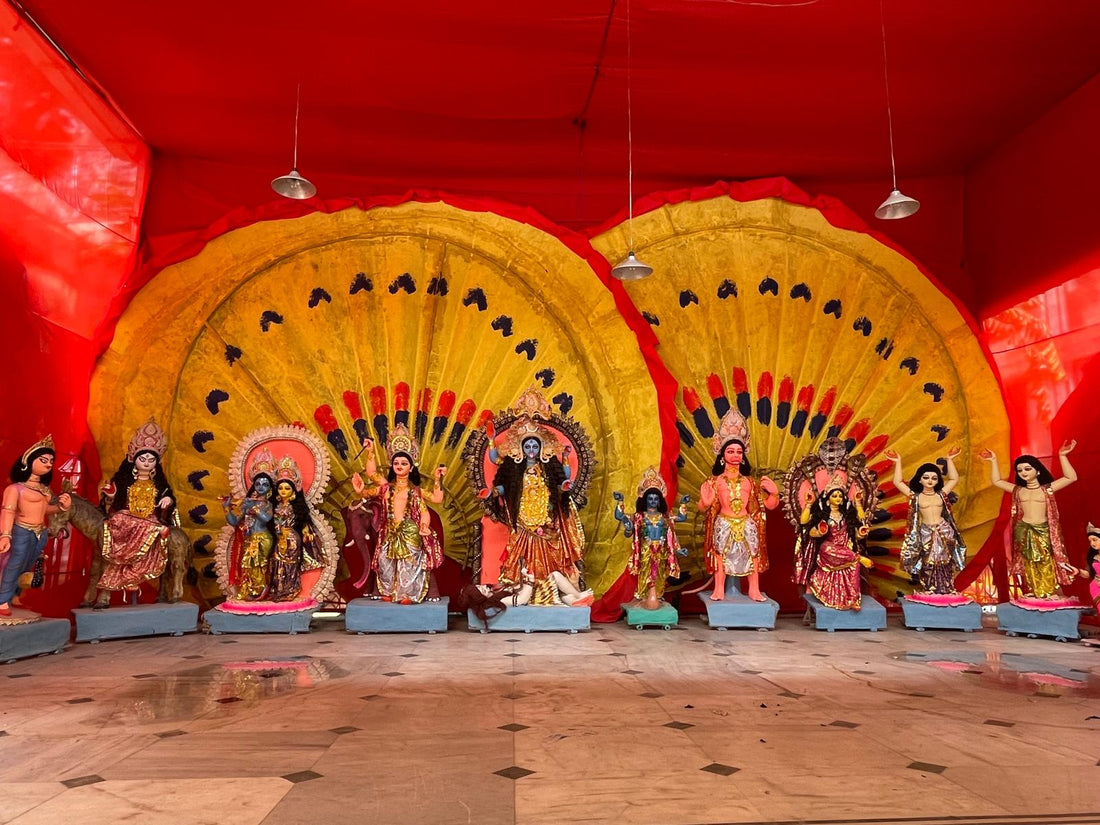
Bengal’s Durga Pandals: Handcrafted Temples of Art and Empowerment
Share
Every autumn, Bengal awakens to a spectacle unlike any other—a celebration where art, devotion, and storytelling converge in breathtaking harmony. Durga Puja is not just a religious festival; it is the beating heart of Bengal’s cultural identity. At its center are the awe-inspiring pandals—handcrafted sanctuaries that rise from bamboo, clay, fabric, and imagination.

As a photographer and a judge for the Times of India Durga Puja Pandal Contest, I had the privilege of witnessing this tradition up close. What I experienced was far more than craftsmanship. It was a reflection of Bengal’s soul.
Handcrafted by Tradition, Built by Hand

Every Durga Puja pandal is a feat of artistry—and entirely handmade by Bengal’s local artisans. No two pandals are the same. There are no blueprints or commercial templates. Instead, each one is born from scratch using sustainable, eco-friendly materials—bamboo, sholapith, natural fibers, and river clay.

These are not temporary structures—they are temples of intention. Months of labor go into their creation. Artisans from rural Bengal, many of whom inherit their skills through generations, spend day and night breathing life into frameworks with their bare hands. The result? A space that feels sacred long before the goddess arrives.

This isn’t just art. It’s a quiet rebellion against mass production—where craftsmanship still triumphs over convenience, and sustainability isn’t a choice but a way of life.
No Two Pandals Are Ever the Same

What sets Bengal’s pandals apart is their unwavering originality. Every year, each community chooses a new theme. Every design, every narrative, every installation is unique—created for this year only, never to be repeated again.
Some tell stories from mythology. Others reflect on global issues—climate change, gender equality, cultural unity. I’ve seen pandals designed like tribal villages, forgotten temples, European opera houses, rural farms, and even outer space. The creativity is boundless—and deeply intentional.
Walking into each pandal felt like stepping into a different world. Some were quiet and reverent, others bold and cinematic. But all of them told a story.
And that’s what makes Durga Puja extraordinary—not just as a visual festival, but as a platform for storytelling through art.
A Land Rooted in Art and Legacy
Bengal has always been India’s cradle of creativity. From the delicate weaves of Jamdani and Baluchari saris to terracotta sculpture, folk painting, and woodwork—craftsmanship is in Bengal’s DNA.

Durga Puja brings these art forms together on a massive, collaborative scale. Idol-makers from Kumartuli sculpt the goddess from Ganges clay with astonishing grace. Bamboo workers, set designers, painters, and fabric artists work in harmony to bring each pandal to life. It’s a synergy of urban vision and rural heritage.
What you see during the festival is not just a celebration—it’s a living exhibition of Bengal’s cultural heritage. One that is created by thousands of artisans and kept alive through passion, pride, and tradition.

More Than a Goddess—A Symbol of Strength
Durga is not just a deity. She is power personified. She is the mother, the warrior, the protector. And through her, the spirit of Shakti—the divine feminine—rises.

Durga Puja is a celebration of this energy. It reminds every woman of her strength, her dignity, her voice. It’s a time when the streets fill with symbols of resilience and courage—not just in the idol of Durga, but in the faces of every woman who sees herself in her.
In many pandals this year, that message was loud and clear. Themes centered around empowerment, identity, and social justice. In one, the goddess stood against gender violence. In another, she symbolized freedom from societal expectations.
This is what makes Durga Puja timeless. It isn’t bound by rituals. It evolves with society—reflecting the very battles and victories women face every day.

Through My Lens: A Personal Perspective
This year, I wasn’t just an observer—I was part of the story. As one of the judges for the Times of India’s Durga Puja Pandal Contest, and as the photographer behind the images you see here, I had the rare opportunity to witness the creation of these spaces up close.
What I saw was far more than art.
I saw artisans working through the night to finish detailing on a bamboo dome. I saw sculptors gently painting the eyes of the goddess—Chokkhu Daan, the sacred act of bringing her to life. I saw entire communities come together—young and old, artists and volunteers—driven not by reward but by love for their craft.
And as I captured each moment through my lens, I realized something: these pandals are not just structures—they are stories etched in clay, devotion, and sweat.

A Festival That Lives Beyond Its Days
Durga Puja may last for five days, but its impact lingers all year. It sustains thousands of artisan families. It inspires generations of creators. It fosters community. And most importantly, it honors the spirit of a woman who rises, always.
Let this blog serve as a tribute—not just to the artisans of Bengal, but to the goddess who lives in every act of creation, every hand that builds, and every soul that dares to rise.
